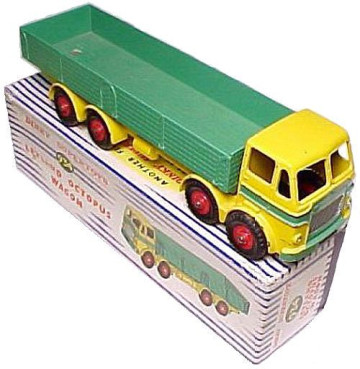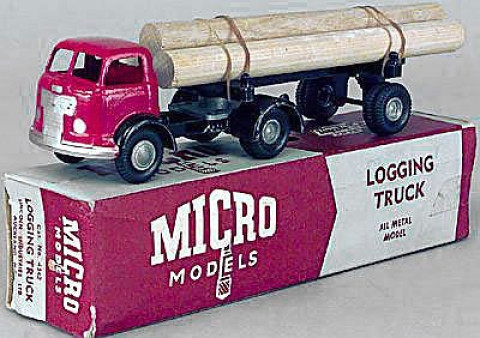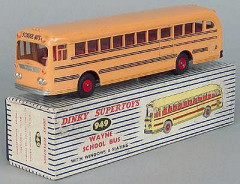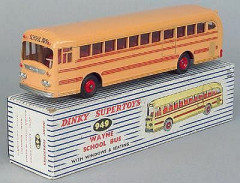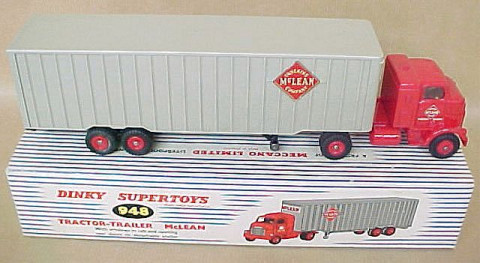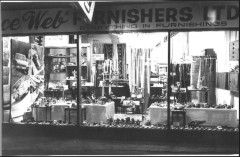I think that it must be my grandparents that are responsible for my interest in model cars. Not those on my father's side. My mother's parents had emigrated from England in 1920. They had left Coventry with my uncle, a tiny baby, but my mother was born in New Zealand.
My mother seems to remember me having a toy jeep when I was two or three, but I cannot remember this and nor can I find it in any of my baby photos. However, it was my grandparents that gave me my first 'Made in England' Meccano product - a Hornby clockwork train set. There was just a circle of track with a green 'tank' type locomotive, coal tender, and a couple of open goods wagons. I think I must have had it before I was five years old and it was great! It was treasured, and always returned carefully to its box after use. There is a little doubt as to when the first Dinky Toy arrived. We know that it was given to me after a trip to hospital, but we are not absolutely sure whether it was after an eye operation when I was five, or after the tonsils operation when I was six.
There is no doubt as to what is was though - a Dinky Supertoys Leyland Octopus Wagon - green and yellow - and I remember 'driving' it down the drive, along the footpath and up the neighbour's drive to show off my marvellous new toy. The fact that there were no vehicles like it on New Zealand roads was of no consequence. Meccano sets began to arrive as Christmas gifts shortly after, and this began a crane building period which lasted for several years.
[Click on any photo to see a larger version]
Dinky 934 Leyland Octopus
My grandfather began to give me a subscription to the Meccano Magazine as my Christmas present about this stage. What a fabulous magazine. Not only did it show off all those Meccano products, particularly Dinky Toys, but it showed off the technological advances and inventions of the British Empire. It was unashamedly conservative, loyal, royalist, mildly sabre rattling (remember it was the time of the cold war and the Korean war) and thoroughly patriotic and was bound to appeal to any boy with an interest in technology at a time when the Empire was still basking in the glory of the War won and colonies to exploit, that is, assist in their development. I loved the articles on giant walking excavators, Foden dump trucks, new bridges that were longer or better than any other in the world, new dams and power stations in the colonies, new ships launched and the latest jet fighter aircraft.
Naturally, it was unashamedly a trade magazine, so Meccano, Hornby clockwork and Dublo electric trains and Dinky Toys were always featured. "The Toyman" wrote the article on the recently issued Dinkies, and his style was rather condescending, but the pictures in his article, and the coloured advertisement on the back cover which also featured the latest releases filled me with desire. And of course, that was a problem. Not only were Dinky Toys rather expensive by the time they arrived in New Zealand, but they were not very easily available. After the war, overseas funds were not to be squandered on luxuries, so import controls and heavy duties were imposed on toys. Those shops that did have licence spent a great deal of time to ensure that every penny of their licence was used on the once a year shipment, usually planned to arrive just before Christmas.
The place that I remember as the major Christchurch supplier was a shop on Colombo Street near the Tuam Street intersection called E. A. Gay, Optician. Mr Gay had started working in another long established family firm of opticians called Proctors. They had a good import licence and were the local suppliers of Meccano products - Meccano itself, Hornby clockwork and electric trains and Dinky Toys. How they happened to have the licence I do not know, but when Mr Gay decided to go out on his own, he was able to procure the licence from Proctors. And as soon as I was old enough, my grubby noseprint and fingerprints joined the many others on Mr Gay's window as I stared at those marvellous Dinky Toys. I don't know if my Leyland came from E. A. Gay's, but I am certain that some of the first Dinkies I owned did so. Of course, E. A. Gay was not the only supplier. I recall that The Farmers, D.I.C. and Whitcombe & Tombs had some, but nowhere as many as E. A. Gay. I assume that the others obtained theirs through Models Limited (of Fort Street in Auckland) as they were the New Zealand agent.
I vividly remember one other store that sold models, and it's not so much because of the models they stocked, but because of the fact that they sold mainly china. Minsons was a long narrow shop on Colombo Street, north of Cathedral Square, that sold good quality china, cutlery and glassware - probably the best range and quality in the city. At the back of the store they had some glass fronted cupboards where they kept their Micro Models. Everyone knows that Micro were not as good as Dinky - certainly not in the mind of this little boy. They were made in New Zealand by Lincoln Industries from dies largely sourced from Australia, and the idea was to supply the toy market without having the import restrictions imposed that limited the supply of imported toys like Dinky. Their Commer trucks did appeal to me, as these were very commonly seen in Christchurch. In fact, a local contractor, Ryan Brothers, had a fleet of Commers. The Ryan Brothers' dump trucks and low-loader were very similar to the Micro versions and were held in high regard alongside my Dinkies. The Micro low-loader carried the Micro bulldozer just like Ryan's. They were very realistic. Now what was special about Micros at Minsons? Well Minsons kept a great deal of their stock on island displays alongside a central aisle that ran down the length of the store. The floor was wooden and when you walked down that very long aisle, every piece of china, on every one of those island displays, rattled alarmingly. It sounded as if every piece of expensive china was going to fall off and break into a thousand pieces - quite terrifying for a shy little boy who just wanted to see the Micro Models at the back of the store.
Micro Models Logging Truck
In about 1960, a family friend went back to England to visit relatives. He was given, if my memory serves me correctly, £20, (a very significant sum at the time) to spend on Dinky Toys for me. The selection that came back was quite eclectic, but from that time on I was a collector! The Wayne School Bus, McLean tractor/trailer, Foden dump truck, Garage kitset, 4 berth caravan , 150 Rolls Royce were amongst some of the models that arrived.
Dinky 949 Wayne School Bus - 2 versions shown - with Black side stripes and with Red side stripes
Two other things happened at about this time. The first was that I discovered that you could buy Dinky Toys from Meccano direct (Meccano Limited, Binns Road, Liverpool 13). Sure it was not very easy. You had to collect 5 shilling British Postal Orders - the only way to purchase sterling currency. You were only meant to get one per day, but by planning a trip around the city you could call in to quite a few Post Offices (yes, they did exist in every suburban shopping centre in those days) and get one at every PO. Then you had to wait up to ten weeks for the surface mail to arrive - and then you had to make a trip into the Customs Office to have the duty assessed - but it was still all worthwhile and a part of collecting in those days.
Dinky 948 McLean Tractor-Trailer
The second thing discovered was Hobdays. Hobdays were a model and cycle shop located at the top end of Colombo Street, very close to the Century Theatre. What is special about the latter you ask? Well my parents had purchased the sweet shop in the theatre (in 1960) and I was naturally employed as a 'sweet boy'. I sold sweets off my tray before the film started and then sold ice creams off my tray during the intermission (sixpence each). If Hobdays' was open, I would kill the time in between my duties covetously looking at their Micro and Spot-On models. They also stocked Matchbox, but there were very few to look at. Import restrictions still applied, and Hobdays also got their main shipment just before Christmas. A huge queue of customers waited for them to open when the shipment arrived, only to have the models rationed out to them. They were all sold in no time.
About 1962 Hobdays imported their first shipment of Corgi Toys, and immediately there was a new brand for me to dream about. I helped them unpack the very first shipment, which made the desire worse. They were "the ones with windows" and made Dinky look rather amateurish. My first Corgi catalogue came from Hobdays, and still has the original New Zealand prices written in my immature hand alongside the models that Hobdays stocked in that first shipment. It is the 1961 catalogue, but it may have been 1962 when it/they arrived here. You may be interested in some examples, with the New Zealand price in shillings and pence [and for our younger readers the equivalent cost expressed in NZ$ and rounded up to the nearest cent ... makes for a useful comparison when one considers the cost of one of these items today! Webmaster]:-
|
||||||||||||||||||||||||||||||||||||||||||||||||||||||||||||
|
This is only about half of that first shipment, and I've still got some of them!
Getting information about models was quite difficult in the sixties. The Meccano Magazine began to falter, and the only other magazine was called Model Cars. As slot cars were fashionable at the time, they featured strongly in the magazine, but there was always a section which showed off the new models, and a few advertisements from the early 'real' model shops - such as Auto Models of Finsbury Pavement or Atkinsons of Swansea - gave information about brands from countries other than the UK, such as Solido, Rio and Tekno. A completely new world was beginning to open up!
I remember seeing a classified advertisement in one issue from a collector in New Zealand and through some fast correspondence I discovered that there were other mad collectors in New Zealand &emdash Clive Geary in Auckland, Maurice Woolley in Palmerston North, Ron Ford in Upper Hutt, Ron Welford here in Christchurch and Eric Brockie in Dunedin. Eric began to talk of the possibility of a club, which I recall was not received with great enthusiasm by the other five. We didn't really think that there were sufficient collectors apart from ourselves for such an idea to be viable. However, Eric persisted, sending us long letters asking for our opinions on how such a club should be formed, how it should run and what it should be called. While this was going on a few more collectors were discovered and an inaugural meeting was held in Christchurch in 1969 followed by the 1st Annual General Meeting a year later.
At that stage, the Canterbury Branch contained a balanced mixture of collectors and kit builders. An annual competition was held for the kit builders, with trophies being obtained for a variety of classes. There was always rivalry between the Canterbury and Otago branches at this stage, with each branch thinking that it had the best competition and the best judging forms. The presentation of trophies was a big affair, sometimes combined with a Christmas party type, end-of-year function. Models were displayed, quizzes were held, gifts were given to the children and a huge supper was arranged. Some thirty people would attend; they were quite grand occasions.
Thanks to a friendly retailer, 500 models from my collection were displayed in the shop window of Lace Web Furnishers, Colombo Street, and I recall that prize winning kitsets in the current branch competition, with trophies and certificates were also displayed in this window on at least one occasion.
Lace Web Furnishers Window display and associated newspaper advertisement
Carville Stewart, Christchurch
